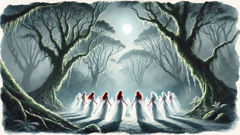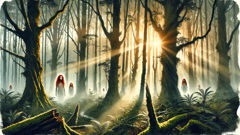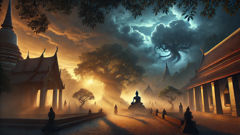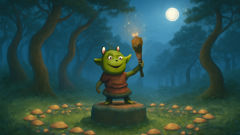Introduction
On the slopes of the Waitakere Ranges, where the ferns grow taller than a man and the silver mist dances in the morning, the land breathes with stories far older than memory. Here, at the edge of the ancient forests of Aotearoa—New Zealand—shadows shift and songbirds cry out at dawn, their melodies weaving through moss-covered branches. In this place where sunlight slants between kauri and rimu trees, an unseen people dwell: the Patupaiarehe. Neither entirely of this world nor wholly of another, these pale-skinned, red-haired beings are the guardians of the deep forest and the swirling fog. Maori elders speak of their music drifting like smoke at dusk, of their laughter echoing in ravines, and of the times when unwary hunters or curious wanderers encountered them on a lonely ridge. The Patupaiarehe are keepers of ancient magic—crafting veils of mist, enchanting travelers, and hiding their villages high on the fog-wreathed mountains. For generations, their world and the world of humankind have existed side by side, separated only by a thin curtain of mist and respect. To walk these woods is to feel the presence of something old and watchful; to listen to the wind is to hear whispers from a time when the world was still young. This is the story of the Patupaiarehe: a tale of enchantment, boundaries, and the fragile balance between the seen and unseen realms that shape the heart of New Zealand.
The Hidden Realm: Secrets of the Mist
Long before the arrival of waka from distant Hawaiki, before the first footprints pressed into the soft black earth of Aotearoa, the Patupaiarehe walked these lands. Their world unfolded in places where sunlight rarely reached—on ridges swaddled in cloud, in gullies always slick with dew, beneath canopies so thick they seemed to swallow the sky. They were a people as elusive as the fog that veiled their homes, and their stories passed among Maori iwi as whispers: warnings, riddles, and songs.

The Patupaiarehe were taller than most men, with skin as pale as moonlight and hair the color of embers or flax flowers. Some said their eyes gleamed blue or green, catching the gleam of twilight. They clothed themselves in fine cloaks woven from the softest flax and the shimmering down of native birds—kiwi, kereru, and pukeko. They wore crowns of silver fern and drifted barefoot through forests that hummed with hidden power. The world they inhabited was not only physical but also spiritual, layered in enchantment. The Patupaiarehe could vanish with the rising sun, dissolve into mist at a glance, and weave spells that could heal or beguile. Their homes—pa, or fortified villages—were invisible to all but a chosen few, concealed by enchantments so strong that even birds would turn aside and rivers would shift their course to protect them.
They lived by night and twilight, shunning the harsh gaze of the sun. Sunlight, it was said, would sap their strength, turning their skin to stone or fading them to shadows. By moonlight, however, their songs rose clear and haunting over the hills: flutes of bone and wood, voices high and pure, melodies that could lull a hunter to sleep or draw a traveler off the path. The Patupaiarehe were skilled in the arts of magic—rongoa (herbal lore), weather-weaving, and the shaping of dreams. Some among them could summon rain or wind, cloak valleys in impenetrable fog, or speak with the tui and riroriro birds.
For all their gifts, the Patupaiarehe were wary of humankind. They watched as the first Maori settlers built villages along the coasts and rivers, lighting fires that glimmered through the night. The Patupaiarehe kept their distance, venturing out only to gather rare ferns, collect dew from spiderwebs at dawn, or to dance in moonlit clearings. Yet, on certain nights—when the veil between worlds was thin—a human might stumble upon a Patupaiarehe gathering. The air would grow cold and heavy, and a strange hush would fall over the bush. Sometimes, a traveler might hear flutes in the mist, or see pale figures moving just beyond sight. Those who followed found themselves lost, wandering in circles, unable to recall how they’d arrived or how to leave. The Patupaiarehe rarely harmed those who respected their boundaries. But those who trespassed on sacred ground, or stole from their groves, risked their wrath: sudden storms, a lingering illness, or a memory lost forever.
One such tale tells of a young hunter named Te Ariki, who, seeking a rare bird for his chieftain’s feast, strayed deep into the Waitakere hills. He followed the sweet, lilting notes of a flute and came upon a clearing bathed in moonlight, ringed with pale figures who danced in a circle, their feet barely touching the mossy earth. The hunter watched in awe as their music rose and fell like a tide, and he felt himself drawn forward, unable to resist. The Patupaiarehe saw him—though he thought himself hidden—and with a single word, the mist thickened, swirling around his feet. When the song ended, Te Ariki found himself alone, the clearing empty, his memory of the path home faded like dew at noon. For days he wandered, sustained only by a trickle of water and the fruits he could find, until at last he emerged from the forest—forever changed, haunted by music only he could hear.
Encounters Between Worlds: Trust and Treachery
As generations passed, encounters between humans and Patupaiarehe grew both rarer and more complex. Maori leaders warned their people never to enter the forests after dusk, never to whistle at night, and never to leave food or clothing where the mist gathered thickest. Still, curiosity—and sometimes necessity—drew mortals into the Patupaiarehe’s realm. The stories that followed became woven into local legend: tales of love, bargains, and dangers that lingered for lifetimes.

One legend told among the Tainui people speaks of a woman named Hinewai, who lived on the lower slopes of Pirongia mountain. She was famed for her skill in weaving and her deep knowledge of rongoa. One evening, gathering medicinal ferns by a mountain stream, she heard a voice singing—soft, strange, and undeniably beautiful. Drawn by the melody, she found a Patupaiarehe man, tall and elegant, his skin luminous in the fading light. He watched her with curiosity, and she saw kindness rather than malice in his eyes. For several nights, Hinewai returned, and together they shared songs and stories. The Patupaiarehe, who called himself Raukura, taught her new weaving patterns and secrets of plants unknown to mortal healers. In turn, Hinewai gifted him a cloak of her own making. But their friendship was fragile: Raukura warned that his people distrusted humans, and that if she revealed their secrets, her memory would be erased by the mists.
The relationship between humans and Patupaiarehe was not always so gentle. Some stories told of men who sought the Patupaiarehe’s knowledge for power. Chiefs who tried to capture them, seeking the secret of their music or their magic cloaks, found themselves pursued by strange misfortunes: a fleet wrecked by sudden storms, a village beset by illness. Others, driven by greed or desperation, tried to steal from the fairy folk—digging up enchanted roots, trespassing on their sacred pa. The land itself seemed to rise up in defense: thick fog that never lifted, rivers that changed course overnight, birds that fell silent for days.
Yet the two worlds were not always at odds. On rare occasions, Patupaiarehe would help lost children or heal a wounded traveler. Sometimes, they left mysterious gifts at the edge of a village: baskets of berries, polished stones that glowed softly in moonlight, or flutes carved from a single bone. These acts were always anonymous, and the recipients were warned to never speak of them or boast about their luck. To honor the Patupaiarehe was to leave offerings at the forest’s edge—sweet kumara, woven mats, or feathers from native birds. In return, hunters found game more plentiful, and fishermen returned home with heavy nets.
But there were always those who tried to bend the old ways. One winter, a reckless young chief named Matiu boasted that he would capture a Patupaiarehe and force them to reveal their secrets. With a band of warriors, he crept into the fog-shrouded mountains, carrying nets of flax and weapons of bone. As they entered a deep ravine, the air grew cold, and a strange silence settled around them. The mists thickened until they could not see one another. Voices whispered in languages they could not understand. When at last the fog cleared, Matiu found himself alone beside a still pool—his warriors gone, their footprints washed away by unseen rain. He stumbled home, his mind broken, forever repeating a song no human could translate.
Conclusion
To this day, the story of the Patupaiarehe lingers in every fold of New Zealand’s wild hills and hidden valleys. The mist that drapes itself across the forests at dawn is said to be their veil; the fluting of birds at dusk echoes their ancient music. For Maori and for all who walk these lands with respect, the Patupaiarehe remain a reminder: not every mystery should be solved, and not every secret should be claimed. The boundaries they guard are both physical and spiritual, marking where the known world ends and the realm of magic begins. The forests are still sacred, alive with memories of those who once danced in the moonlight and vanished with the sun. To step quietly among these trees is to honor an old promise—to respect what cannot be seen, to listen for music in the mist, and to remember that wonder often hides just out of sight.













